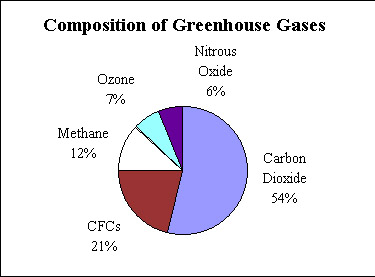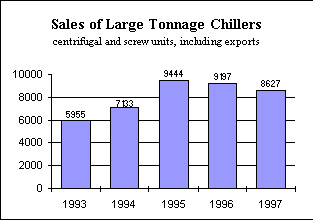Ozone depletion and climate change are issues that concern environmentalists, scientists, and ordinary citizens. Depletion of the earth's protective ozone layer occurs when industrial chemicals-mainly chlorine and bromine-reach the stratosphere. Climate change, a separate but related phenomenon, results from an increase in greenhouse gases in the earth's environment. Carbon dioxide, a product by the fossil fuel combustion, is the main culprit in global warming, but chlorofluorocarbons (CFCs), methane, ozone, and nitrous oxide also contribute to the problem.
 Source: Trane Company
Source: Trane CompanyThis article examines ozone depletion and climate as they relate to the air conditioning and refrigeration industry, and in particular the market for large-tonnage chillers. It discusses the industry's contribution to these environmental problems as well as steps it has taken to reduce emissions of ozone-depleting refrigerants and increase the energy efficiency of its products. The box below provides additional details on chiller technology.
Ozone Depletion: On the Right Path
Over the past 60 years, the growing use of air conditioning has played a role in the increased emissions of greenhouse gases and ozone-depleting chemicals, such as CFCs. CFCs have been widely used as refrigerants since the 1930s, and for many years, they were considered inert gases. However, we now know that when CFCs are discharged into the atmosphere and come in contact with solar ultra-violet rays, they disintegrate releasing chlorine gas that damages the earth's protective ozone layer. It was not until 1974 that scientists first demonstrated the potential for significant ozone depletion based on the projected use of CFCs
CFCs make up the bulk of man-made ozone depletion substances, comprising over 70% of the total. Their detrimental effect is compounded by their long lives. For example, CFC-11 and CFC-12, two of the most commonly used refrigerants, have atmospheric lives of 50 and 100 years, respectively. As much as 15-20% of the CFCs released in the past can be attributed to the air conditioning and refrigeration products.
The Montreal Protocol, an international agreement intended to curb the production of chemicals harmful to the ozone layer, was adopted in 1987. This agreement and subsequent amendments included a timetable setting dates by which participating nations would stop the manufacture of air conditioning and refrigeration equipment that uses harmful refrigerants as well as discontinuing production of the refrigerants themselves. The first target date was January 1, 1996, when the production of CFC-11 and CFC-12 was banned along with the manufacture of equipment using these products. Initially these refrigerants were replaced with more benign HCFCs (hydrochlorofluorocarbon) products, but these too will be phased out in favor of chlorine-free refrigerants, such as HFCs (hydrofluorcarbons).
| Refrigerants | Phase-Out Date | Action |
|---|---|---|
| CFC-11, CFC-12, HCFC-152A, CFC-114, CFC-500 | 1996 | Equipment using this refrigerant is no longer manufactured. Refrigerant is no longer produced. |
| HCFC-22 | 2010 | Equipment using this refrigerant is no longer manufactured. |
| 2020 | Refrigerant is no longer produced. | |
| HCFC-123 | 2020 | Equipment using this refrigerant is no longer manufactured. |
| 2030 | Refrigerant is no longer produced. | |
| Source: E Source, Space Cooling Technology Atlas, reproduced in www.epa.gov | ||
Although production of CFC-11 and CFC-12 has ended, and new refrigerants and equipment are available, the old standards continue to be widely used in equipment made before the 1996 deadline. The effect of the manufacturing ban has been to raise the price of existing supplies of CFC-11 and CFC-12 and to encourage conservation. As the price increased, some consumers invested in new equipment to replace aging units, but many others repaired the leaks in their existing systems, thereby reducing their need for expensive refrigerant top-ups. Repair and conserve was the most prevalent reaction in the chiller market, where capital costs of replacement units are high and the equipment has an operating life of 20-30 years or more. A secondary market has emerged for cleaned and reclaimed refrigerants.
Anticipating the ban on CFC refrigerants, chillers manufacturers designed equipment that used alternative refrigerants. Immediately ahead of the refrigerant ban, sales of new large-tonnage chillers rose sharply, from 5,955 units in 1993 to 9,444 units in 1995, according to data from the Air Conditioning, Heating and Refrigeration Institute (ARI). Since 1995, though, sales have fallen, registering only 8,627 units in 1997. ARI expects this decline to continue through the year 2000, despite the fact that 64% of the 80,000 chillers using CFC refrigerants remain in operation.
In the chiller market, it appears that the most cost effective replacements have been made, and further gains in the campaign to limit and reverse environmental damage from CFC refrigerants will be harder to effect.
Climate Change: A Problem for the 21st Century
The problem of ozone depletion has been well studied, and the steps have been taken minimize the current impact of CFCs and ban their future production. Scientific findings indicate that the peak in stratospheric chlorine loading is imminent and may have already passed . Concern about the earth's ozone layer has been superseded with worries about climate change. An international agreement, the Kyoto Protocol, was drafted in December 1997 to address this issue.
Emissions of carbon dioxide have increased rapidly since the beginning of the Industrial Revolution, and the atmospheric concentration of carbon dioxide has increased by nearly 30% since 1860. In the last 50 years, annual global carbon emissions have nearly quadrupled to 6.25 billion metric tonnes in 1996. Some scientists believe these conditions have and will lead to dramatic changes in conditions on earth, including an increase in the average temperature, the melting of the polar ice caps, and a rise in the level of the seas.
The Kyoto Protocol, ratified on December 11, 1997, called for an average 5.2% reduction in emissions of six greenhouse gases-including carbon dioxide and hydrofluorcarbons (HFCs)-from a 1990 base. Although the initial accord yielded mixed results by it's end in 2012, governments continue to work on the issue and have extended the agreement through 2020.
In the chiller market, the conversion to more energy efficient units will have an effect on the emission of carbon dioxide and other greenhouse gases. For example, the Trane Company estimates that if the efficiency of centrifugal chillers was increase by about 15%, from 0.56 kW/ton (the industry's average efficiency) to 0.48 kW/ton (the industry's best efficiency), annual power plant emissions would be reduced by nearly 7.7 million tonnes of carbon dioxide, over 64,000 tonnes of SO2, and over 27,000 tonnes of Nox . The US EPA notes that older chillers, with efficiencies ranging from 0.8-1.0 kW/ton, often consume approximately twice the energy of newer, more efficient units.
Capital Costs Hinder Move to New Equipment and Reduced Emissions
The air conditioning and refrigeration industry responded to the ban on CFC refrigerants and the need for increased energy efficiency by redesigning its products. Systems that use chlorine-free refrigerants are now available across the product line -- from residential units to large commercial applications. In the commercial market, the non-CFC chillers currently available are 30-40% more efficient than CFC units installed 20 years ago. Although some of these operating savings are masked by today's lower energy costs, with the deregulation of the electric utility industry and the adoption of peak-loading and real-time pricing, the cost savings can still be substantial.
While new equipment designs will limit environmental problems and lower operating costs, the move to replace older, existing chillers has been slower than expected. For many building owners, the capital cost of new equipment presents a strong deterrent to change, even in view of typical energy savings of 15-35% for new central chiller installations. Moreover, when other energy saving measures are undertaken at the same time, it may be possible to reduce overall cooling requirements. Often, the replacement of an older over-sized chiller with new right-sized equipment can result in energy savings of up to 50%.
The ARI has proposed the use of tax policy incentives, such as accelerated depletion and/or tax credits for the purchase of new equipment, in order to ease the burden faced by building owners seeking to install equipment that provides environmental benefits. Incentives that lower the initial costs of new chillers would help the environment. Air conditioning manufacturers and their suppliers-including copper tube producers-are ready to the demands for a safer environment.

 Source:
Source: